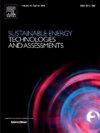Towards a low-carbon city: A study on the user perception and public acceptance of semi-transparent solar window technology in Hong Kong
IF 7.1
2区 工程技术
Q1 ENERGY & FUELS
Sustainable Energy Technologies and Assessments
Pub Date : 2025-06-30
DOI:10.1016/j.seta.2025.104437
引用次数: 0
Abstract
This study investigated the public acceptance and perception of semi-transparent photovoltaic (STPV) window technology in Hong Kong through a comprehensive mixed-methods approach. The research consisted of three phases: an on-site experimental study, annual energy performance simulation, and a large-scale social survey.
In the first phase, we designed and installed STPV prototypes in a residential mockup, conducting electrical and daylight measurements while assessing user comfort through physiological and psychological evaluations with 36 participants. The second phase involved simulating energy performance using DesignBuilder software to compare STPV with single glazing and vacuum glazing over a 20-year period. The third phase utilized a bilingual questionnaire to collect data from 105 diverse respondents on their awareness, acceptance, and perceptions of STPV technology.
Results demonstrated that STPV windows achieve excellent optical performance comparable to natural daylight. While participants in the test room with STPV windows reported satisfactory visual comfort. The third phase’s public survey revealed 65% support for STPV installation, with reducing electricity bills and sustainability as the main driving motives. However, high costs and lack of awareness were identified as key barriers.
迈向低碳城市:香港半透明太阳能窗技术的用户认知及公众接受度研究
本研究通过综合的混合方法,调查了香港公众对半透明光伏(STPV)窗技术的接受程度和看法。研究分为三个阶段:现场实验研究、年度能源性能模拟和大规模社会调查。在第一阶段,我们在住宅模型中设计并安装了STPV原型,进行电气和日光测量,同时通过36名参与者的生理和心理评估来评估用户的舒适度。第二阶段涉及使用DesignBuilder软件模拟能源性能,将STPV与单层玻璃和真空玻璃在20年内进行比较。第三阶段利用双语问卷收集105名不同受访者对STPV技术的认识、接受和看法的数据。结果表明,STPV窗具有与自然光相当的优异光学性能。而在有STPV窗户的试验室里,参与者报告了令人满意的视觉舒适度。第三阶段的公众调查显示,65%的人支持安装STPV,减少电费和可持续发展是主要的驱动动机。然而,高成本和缺乏认识被认为是主要障碍。
本文章由计算机程序翻译,如有差异,请以英文原文为准。
求助全文
约1分钟内获得全文
求助全文
来源期刊

Sustainable Energy Technologies and Assessments
Energy-Renewable Energy, Sustainability and the Environment
CiteScore
12.70
自引率
12.50%
发文量
1091
期刊介绍:
Encouraging a transition to a sustainable energy future is imperative for our world. Technologies that enable this shift in various sectors like transportation, heating, and power systems are of utmost importance. Sustainable Energy Technologies and Assessments welcomes papers focusing on a range of aspects and levels of technological advancements in energy generation and utilization. The aim is to reduce the negative environmental impact associated with energy production and consumption, spanning from laboratory experiments to real-world applications in the commercial sector.
 求助内容:
求助内容: 应助结果提醒方式:
应助结果提醒方式:


